WBBSE 10th Class Social Science Solutions History Chapter 3 Resistance and Rebellion : Characteristics and Analyses
WBBSE 10th Class Social Science Solutions History Chapter 3 Resistance and Rebellion : Characteristics and Analyses
West Bengal Board 10th Class Social Science Solutions History Chapter 3 Resistance and Rebellion : Characteristics and Analyses
WBBSE 10th Class History Solutions
- The Chuar tribesmen of Midnapore district, took up arms (1798-99). When the East India Company increased the rate of land revenue in the regions of Dhalbhum and Manbhum oppression. In 1768, the Rajas of Dhalbhum, Kaliapur, Dholka and Barabhum organised a revolt. This disturbed condition continued till the end of the 19th century.
- In 1820, the Raja of Singbhum acknowledged the supremacy of the British Government. The restless Kol tribe of Chotanagpur resented the agreement and broke into a rebellion in 1831-32. They killed or burnt the houses of about a thousand landlords. The rebellion spread to Singhbhum, Ranchi, Hazaribagh and Western parts of Manbhum. The Kols were unsuccessful and order was restored after a large scale military operation.
- The Santhal Revolt of 1855 had its origin in the revenue experiments of the East India Company. The zamindars denied the santhal peasants the right of ownership over land. The santhals rebelled under the leadership of Sidhu and Kanhu. They declared the end of the East India Company’s rule and proclaimed themselves independent. The situation was brought under control in 1856, after extensive military operations. Consequently, a separate district of Santhal Pargana was created by the government.
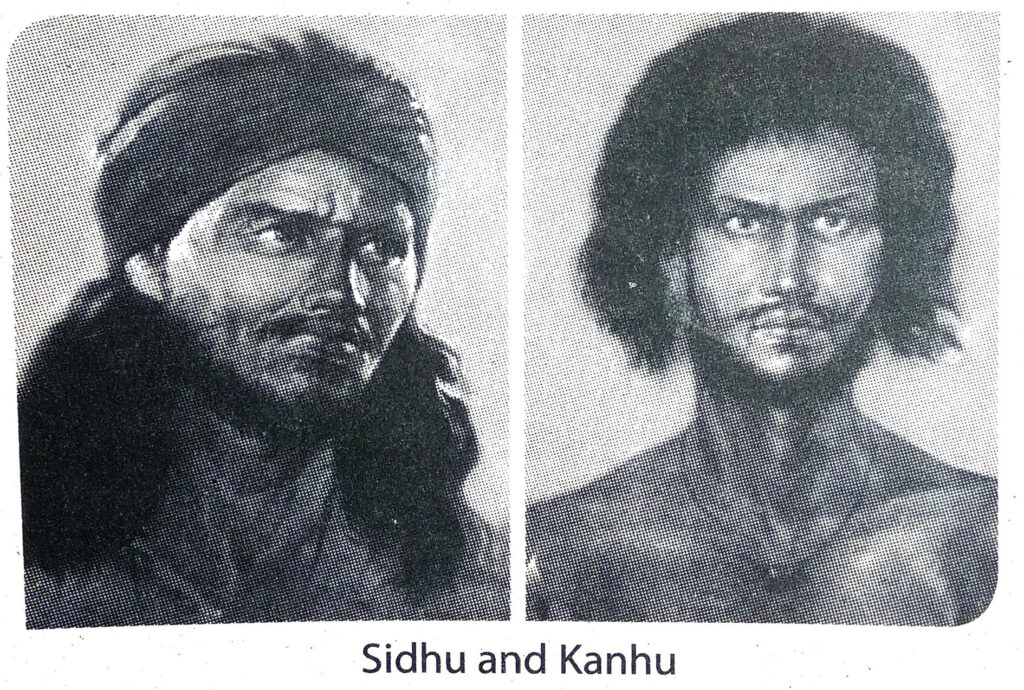
- The Munda Revolt, which swept over Ranchi in 1899-1900, was led by Birsa Munda. The Mundas rose in revolt against the restrictions imposed by the British on their traditional rights on the produce of the forest and their land. Their revolt rocked the foundation of the British empire and Birsa Munda was arrested. Consequently the British adopted some conciliatory measures for the Mundas which included abolition of ‘Beth begari’.
- A sect of Sannyasis and a large number of Fakirs (Muslim mendicants) rose in rebellion against the oppressive tax collection by the British. The immediate cause of the uprising was the restriction imposed by the British upon visiting holy places and shrines. The Sannyasi Rebellion was led by Bhabani Pathak and Devi Chaudhurani. The Fakirs led by Majnu Shah and Chirag Ali also proved troublesome for the East India Company. But the leaders and were inexperienced overpowered by the company’s army.
- The Wahabi movement in India was led by Syed Ahmed Barelvi. In Bengal, the Wahabi Movement was led by Titu Mir. He organised the poor peasants from the communities against the oppressive zamindars, moneylenders and the indigo planters. This was the first armed rebellion of the peasants of Bengal. Titu and his comrades were killed in a valiant fight with the British.
- The Farazi Movement, under the leadership of Haji Shariatullah, started as an Islamic revivalist movement but ultimately it turned into struggle aiming at the expulsion of the British and the restoration of Muhammedan power in India. After Shariatullah’s death, his son Dudu Miyan took up the leadership. He united the peasants against the tyranny of the zamindars and the indigo planters. He created a parallel government and was consequently arrested and imprisoned.
- The Indigo Revolt started in 1859 in Nadia district under the leadership of Bishnu Charan Biswas and Digambar Biswas. From the beginning, the ryots were forced to cultivate indigo by the British planters without legitimate wages. The peasants took the vow not to cultivate indigo any more. The Indigo Rebellion is memorable for the support it received from the educated Bengali middle class. As a result, the indigo plantation received a permanent setback in Bengal.
- The poor peasants of the Pabna district of East Bengal started a revolt against the exploitation of the Zamindars in 1870. Two leaders of the revolt were Ishan Chandra Ray and Khoodi Mollah. In 1874 an agrarian league was formed which protested against the urgent demand of the Zamindars. In 1885 the Bengal Tenancy Act was passed which to a great extent protected the interest of the ryots.
TOPIC – A
Answer in 15 to 16 sentences
- Rebellion
- Meaning: Rebellion refers to the movement made by masses demanding a change in the existing rules and laws. A rebellion can both be long term or short term in nature. If the rebellion is successful, the existing laws and orders can be changed, and if the rebellion is not successful, then also, change is possible as a result of its reaction.
- Example: During the British rule in India several rebellions took place such as the Rangpur Rebellion, Indigo Rebellion, Pabna Rebellion etc. The Sepoy Mutiny (1857) is another example of a rebellion.
- Uprising
- Meaning: Uprising refers to the efforts of a group of people to change the government or leader of a country. Uprisings are generally short termed in nature.
- Example: (a) Sepoy Mutiny in the year 1857 where a part of the British army gathered together for an uprising against the British rule. (b) Naval Uprising in 1946.
- Revolution
- Meaning: Revolution means a quick change in the existing system. A revolution is generally more widespread in nature than a rebellion or an uprising.
- Example: (a) The Industrial Revolution in Europe led to widespread change in the pattern of trade and commerce in the eighteenth century. (b) The French Revolution in 1789 led to overall change of the legal and ruling system in France.
Revolt, uprising and rebellion have a very fine line of distinction, and thus, in most cases, these three cannot be distinguished from one another.
- The rent question created discontent among the Santhals. The rate of tax went on increasing continuously and the Santhal peasants found it difficult to pay.
- Besides regular tax certain illegal taxes were also collected from the Santhal peasants oppressively by the naibs and tax collectors.
- The Santhals were also oppressed by the money lenders who charged high rate of interest from the Santhal peasants ranging from 50% to 500%.
- The European contractors were also oppressive. They were subjected to oppression like taking of kids, fowls, etc. without making any payment.
- The Santhals became convinced that complaints made in the court or higher officials would be of no avail. So they took up arms against the oppressors.
- A new administrative zone for the santhals named ‘Santhal Pargana’ was created by the government.
- The revolt exposed the true naute of colonial exploitation of the people.
- The revolt represented the revolt of the subaltern people against the colonial power.
- Though the rebellion failed the santhals drew inspiration from it and subsequently organised another resistance movement against the British.
- Though the Santhal Rebellion was a failure it inspired peasent movements accross various places of India against the British rule.
- The Santhal Rebellion marked the unity of people from all castes and races.
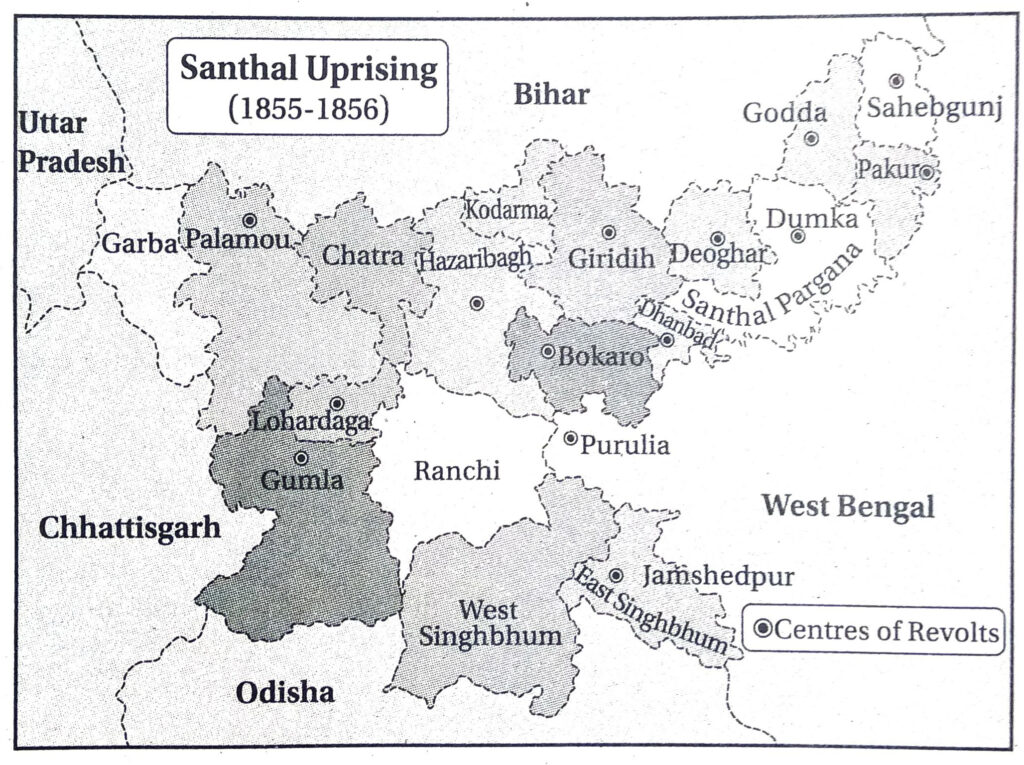
- The Munda Revolt which swept over Ranchi in 1899-1900 was led by Birsa Munda. The Mundas, one of the ancient tribal communities, believed that land was a property of the community. However, the colonial rulers forcibly superimposed upon them, a new set of agrarian relations during the 19th century.
- The Jagirdars or thikadars started using the Mundas as labourers. They were forced to perform ‘beth begari’ or wageless forced labour.
- Moreover, the British rule introduced a new system of land revenue and encouraged the missionaries to enter into the Munda areas.
- The Mundas launched complaints in the courts through lawyers, who eventually cheated them.
- The Mundas lost the world to which they were accustomed. Thus, the Munda discontent eventually led to the tribal resistance in the history of colonial India.
- Early life: Birsa Munda was born in Ulihat village of Ranchi district in 1875. His father, Sugan Munda was a sharecropper. Birsa completed his early education from the Christian missionary school.
- Propagation of religion: Birsa started to propagate a new religion from the year 1895. He proclaimed himself as an incarnation of God and he claimed that he had a vision of God. He made a prophecy of the deluge. He was against the prevalent superstitions of the Munda community. He was also against animal sacrifice. He raised a question on the sacred thread ceremony of the Mundas.
- First movement: When the British government started acquisition of fallow lands of the Munda village during 1893-94, Birsa started his first movement against the British government.
- Initiation of the revolt: Birsa organised the people of the Munda tribe in the year 1899 and announced a revolt against the British rule. December 24, 1899 was declared as the day of the initiation of the revolt.
- Spread of the revolt: The month of January in the year 1900 witnessed the revolt under Birsa Munda at its extreme point. The people of the Munda tribe attacked the government offices, police stations, and government officials.
- Death: Though the people of the Munda tribe under the leadership of Birsa Munda fought bravely against the British army, but they could not win over them. Birsa was captured and imprisoned at the Ranchi jail, where he died at a young age of 25 years, after suffering from cholera.
Analytical Answer (AA) Type Questions
Answer in 7 to 8 sentences
- Lack of efficient leadership: There was no efficient leader of the Kol Rebellion. Leaders like Buddhu Bhagat, Joa Bhagat lacked proper leadership skills. So this rebellion did not last for long.
- Limited area of operation: To make the rebellion successful, it was necessary to spread the rebellion outside the limited boundaries of areas inhabitated by the Kol tribe. But this did not happen and it weakened the movement.
- Non-cooperation by the educated people and intellectuals: The Kol Revolt was not supported by the educated people and the intellectual class of the society. So the revolt was not well planned and properly organised.
- Lack of communication: There was severe lack of communication between the people of the Kol tribe residing at different places. So the rebellion could not gather up enough strength.
- Weakness: The financial aids as well as arms and ammunitions required to make a revolt successful were not present at the disposal of the Kols. So the revolt weakened from the very beginning.
- British power: The British were far more efficient in terms of arms and ammunitions. They were also well organised and had modern communication equipments to maintain communication among themselves. The cruelty of the British rulers broke the very backbone of the Kol Revolt.
- Armed tribal movement: The Chuar Revolt was an armed tribal movement.
- Fight against the British rule: The Chuar Revolt was mainly a revolt against the British rule. The Chuar tribe vehemently protested against the exploitation and barbaric torture of the British rule.
- Unity among the peasants and zamindars: The Chuar Revolt was not a revolt against the Indian zamindars. It was a revolt which witnessed the unity amongst the zamindars and the peasants.
- Duration: The Chuar Revolt lasted from 1767 to 1799. It continued for a span of 30 long years. The revolt was led by various leaders at different points of time.
- Two phases: The long period of Chuar Revolt can be divided into two phases. The first phase continued from 1767 to 1768, and the second phase continued from 1798 to 1799.
- Acts of cruelty and torture: To subjugate the Chuar ‘Revolt, the British government initiated acts of cruelty and torture against the Chuar tribe. They killed Rani Shiromoni and arrested Durjan Singh.
- One of the early revolts and rebellions: The Chuar Revolt was one of the early movements against the British rule. The revolt initiated by the illiterate and so called backward Chuars paved way for the revolts that took place in the next century.
- Unity among the peasants and zamindars: The Chuar Revolt was not a revolt against the Indian zamindars. It was revolt which witnessed the unity amongst the zamindars and the peasants.
- Formation of ‘Jungalmahal’: To impose strict restrictions against the Chuar tribe, the British government changed the law and order. A separate district named ‘Jungalmahal’ was established surrounding the city of Bishnupur, to control the Chuars.
- European foresters felt that land used for Jhum cultivation could not grow timber trees necessary for making railway sleepers.
- Shifting cultivation also made it difficult for the government to calculate and collect taxes.
- Moreover, when a forest was burnt, there was a danger of the flames spreading and burning the valuable timber trees.
- The daily activity of the villagers-Cutting wood for building houses, hunting, fishing and collective fruits became illegal.
- Millions of people suffered as grazing and shifting (jhum) cultivation were banned. Due to governments ban on shifting cultivation, many people were forcibly displaced from their homes. Some had to change occupation while others rebelled against the government.
- Women who used to collect fire-wood became very worried as they were unable to collect wood.
- English ships could not be built without a regular supply of timber. Moreover, imperial power could not be protected and maintained without ships.
- The spread of railways from the 1850s created a new demand for wood. In India the colonial authority felt that railways were essential for effective colonial internal administration, colonial trade and for quick movement of Company’s troops.
- To run locomotives, wood was needed as fuel and to lay railway lines wooden sleepers were essential to hold the track together.
- The colonial authority also paid attention so that Adivasi and other peasant users do not cut the trees for their personal use or to obtain things for sale or for their own animals, etc.
The Indian Forest Acts caused great hardship to the villagers and they rose in revolt.
Short Answer (SA) Type Questions
Answer in 2 to 3 sentences
- Tribal people like the Mundas and the Oraons joined the Kol Rebels.
- The target of the attacks were the zamindars, grain merchants, mahajans and British officials.
- The Kol Rebels gradually turned against the English who were indiscriminately massacred and looted.
- It was a rebellion of the tribal people against the colonial rulers.
- It was a protest of the poor peasants and workers against British imperialism.
- By nature, it was a resistance movement of the peasants and labourers against the British rule-supported by the potters, weavers, chamars and domes.
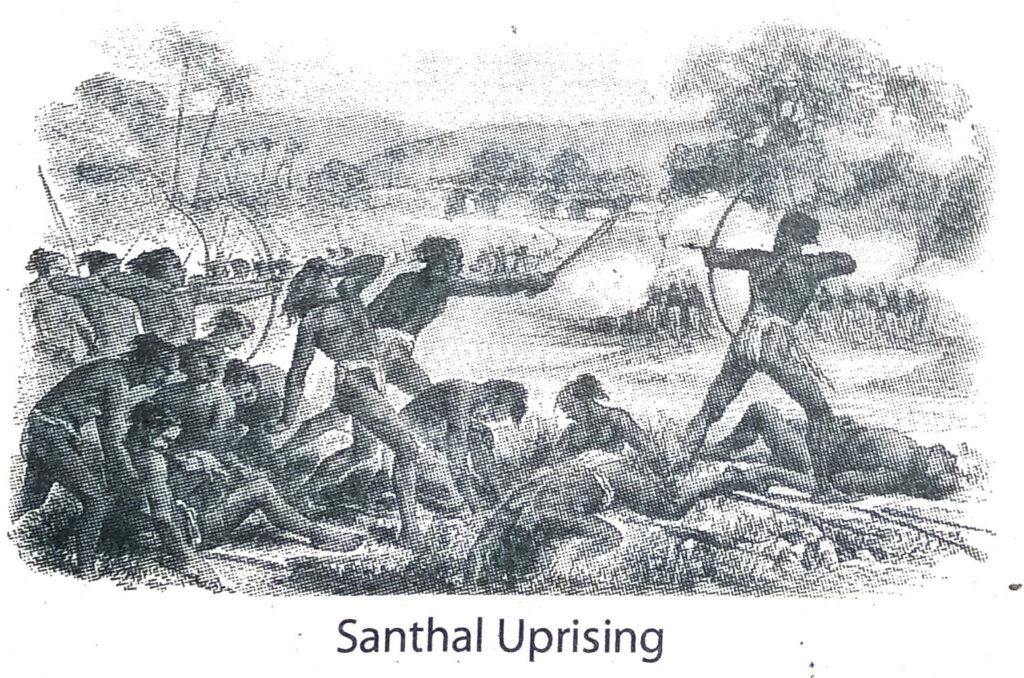
- The Mundas sought to reassert their rights as the real owners of the soil, and to expel the middlemen and the British.
- The British imposed restrictions on the traditional rights of the Mundas. So, the Mundas tried to establish ‘Mundaraj’ and protect their traditional rights.
- The Mundas had no faith on the British administration and law courts. So, in order to protect their rights, they took to violence.
- The British stopped the practice of shifting cultivation, hunting and collection of forest produce.
- The British decided to reserve two-thirds of the forests in 1905.
- Land rents were increased. Colonial officers demanded free labour.
Very Short Answer (VSA) Type Questions.
Answer in one sentence
Fill in the blanks
Multiple Choice Questions (MCQ)
TOPIC – B
Answer in 15 to 16 sentences
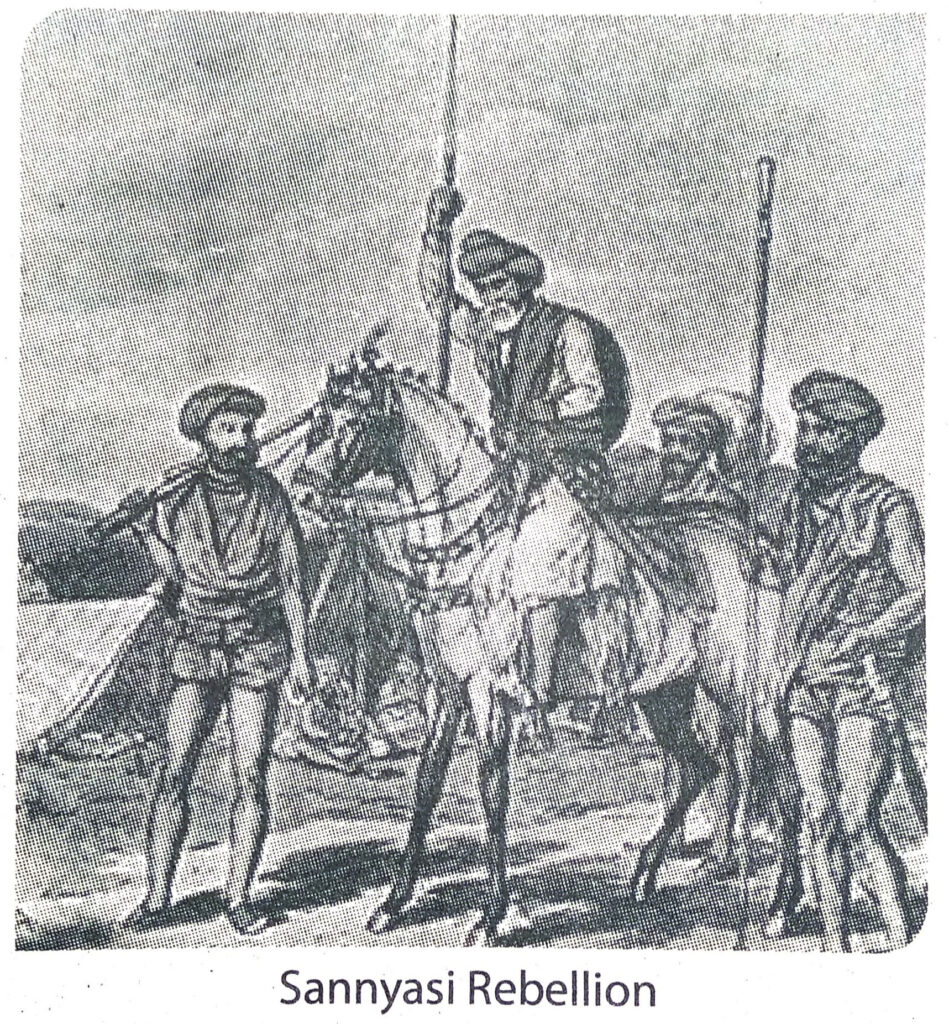
- Titu Mir: The movement was carried in Bengal by Mir Nisar Ali popularly known as Titu Mir who was a believer in the Wahabi ideal of Islamic reform.
- Aim of Titu Mir: Titu Mir’s aim was the replacement of British rule by Muslim rule and the extinction of the British government. He proclaimed “the sovereign power as the hereditary right of the Muslims which had been unjustly usurped by the Europeans”. His aim was also to organise the poor Hindu and Muslim peasants to fight agianst the oppressive zamindars who imposed punitive taxes on the Wahabis.
- Barasat uprising: The Barasat uprising (1831) was led by Titu Mir. The centre of his movement was Narkelberia at Barasat. He organised his followers and built a bamboo fortrees (Banser Kella). Loot, murder, arson and cow slaughter alarmed the local authorities. Titu Mir along with his three hundred followers attacked the house of zamindar Krishnadeva Ray. He assumed the title of Badshah and established a parallel government in Narkelberia. The British government sent a large force and Titu Mir’s bamboo fortress was blown to pieces. Titu Mir was killed and his followers were imprisoned. Many of them were hanged.
Analytical Answer (AA) Type Questions
Answer in 7 to 8 sentences

- The most important feature of the movement was that it started as an Islamic revivalist movement but ultimately it turned into an anti-imperialist as well as anti-British struggle, aiming at the restoration of Muhammedan power in India.
- The movement was non-communal in nature.
- It was a part of the freedom movement of India and the rebels aimed at ousting the British from India.
- A parallel government was established which started collecting taxes from the people and also established local courts.

- The revolt exposed the true nature of British exploitation of the peasants.
- It was the first armed rebellion of the peasants of Bengal against the British, the indigo planters, the zamindars and the moneylenders.

- The Wahabi Movement started as an Islamic reform movement, but ultimately it turned into an anti-imperialist struggle.
- In Bengal, under the leadership of Titu Mir, the movement turned into a rebellion of the peasants, exploited at the hands of the zamindars and European indigo planters.
- It was a movement launched by both the Hindus and the Muslims and hence, was non-communal in nature.
- It was a part of India’s freedom movement. Its aim was to oust the British from India.
- Wahabi Movement in Bengal, led by Titu Mir, was messianic in nature.
Short Answer (SA) Type Questions
Answer in 2 to 3 sentences
- The rebels failed because the leaders were inexperienced.
- Communication prevented them from fighting unitedly against the British.
- The rebellion was limited to a small region.
- The rebels were not popular among all classes of people.
- Initially the objective of the Wahabi Movement were religious. Syed Ahmed’s aim was to convert ‘Dar-Al-Harb’ (Unholy Land) into ‘Dar-Al-Islam’ (Land of Islam).
- The economic objective of the movement was to free the peasantry from economic exploitation.
- Ultimately the movement turned into an anti-imperialist struggle aiming at driving out the British from India.
Very Short Answer (VSA) Type Questions
Answer in one sentence
Fill in the blanks
Multiple Choice Questions (MCQ)
TOPIC – C
Answer in 15 to 16 sentences
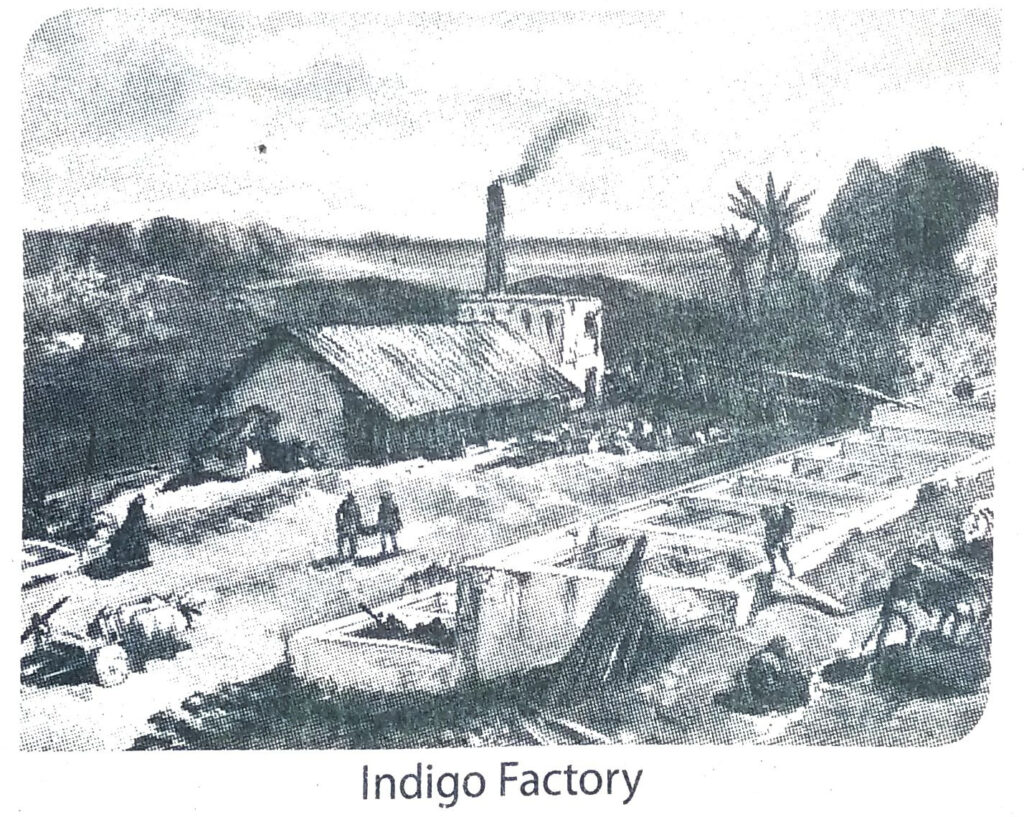
- The wages paid by the planters to ryots were meagre although the prices of agricultural products doubled.
- The planters oppressed the cultivators and forced them to grow indigo under terms.
- The production of food crops declined considerably because the indigo planters used the best plots of cultivable land for indigo plantation.
- The indigo planters augmented the plantation area and evicted the peasants from their villages. Employing armed gang men, the planters did not hesitate to burn the peasants’ huts.
- Peasant women were abducted regularly and other family members were also not spared.
- It was not directed against the zamindars and the mahajans. It was a revolt against the indigo planters who committed all sorts of brutality to force the peasants to cultivate indigo.
- The ryots not only resisted forced cultivation but also wanted to put an end to indigo cultivation.
- The bravery and sacrifice of the peasants deserves special mention. One after another the peasants joined the movement and took the vow not to cultivate indigo.
- All communities-Hindus and Muslims joined the rebellion. Not only the peasants, but the zamindars, businessmen, talukdars and patnidars also joined them.
- The Indigo Rebellion was by nature not a part of religious reform movement. Peasants form the core and took the opportunity to give vent to their grievances against the oppressors.
- The Christian missionaries backed the peasants. Grant, the lieutenant governor of Bengal, and W S Seton Karr were also sympathetic towards the innocent peasants.
- In 1980, the indigo cultivators of Chowgacha village of Nadia district, first rose in rebellion under the leadership of Bishnu Charan Biswas and Digambar Biswas. They organised the peasants of their village Chowgacha, who took the vow not to cultivate indigo any more. The rebellion spread from one village to another and the villagers took a similar vow not to cultivate indigo.
- At this stage, the educated community joined the peasants. Sisir Kumar Ghosh organised peasants of ninety-two villages who took the pledge to refuse indigo cultivation, even at life risk.
- In 1860,, Dinabandhu Mitra, then a high Government official, published the historic drama ‘Nil Darpan’, depicting the brutalities of the English planters and the heroic resistance of the peasants. The Bengali poet Michael Madhusudan Dutta translated this drama into English, but it was published in the name of Reverend James Long. The planters filed a case against James Long who was imprisoned for one month and fined one thousand rupees. Kaliprasanna Singha, a young writer paid off the fine on the spot.
- Harish Chandra Mukherjee, the editor of the Hindoo Patriot, published the news of the tyranny of the planters and the reaction of the peasants. He, through his fiery editorials, considerably influenced public opinion against the British government. Moreover, through his news and views, he greatly influenced the government to appoint the Indigo Commission in 1860.
- Expression of grievances: The first phase of the rebellion was marked by expression of grievances by the indigo ryots against the European indigo planters at the governmental departments.
- Boycott: The expression of grievances was of no good for the indigo ryots. So the second phase of the revolt was marked by refusal of the indigo ryots to take advances for cultivation and thus the boycott of the movement. Digambar Biswas and Bishnucharan Biswas of Nadia district led the boycott movement. A large number of peasants in Nadia, Pabna, Faridpur, Barishal, Rajshahi, Khulna, Maldah, Murshidabad, and Dinajpur did not start cultivating indigo despite of the inhuman torture and oppressions carried out against them.
- Armed rebellion: The indigo ryots started an armed rebellion against the Britishers on the third phase of the rebellion. They burnt the indigo plantations and also attacked the European indigo planters.
- Role of the educated middle class: A section of the educated middle class in Bengal supported the Indian ryots and expressed their grievances against the European indigo planters. [i] The editor of ‘Hindoo Patriot’ Harish Chandra Mukherjee questioned for the indigo ryots and vehemently expressed his views against the European indigo planters. [ii] Dinabandhu Mitra in his drama ‘Nil Darpan’ pointed out the inhuman torture of the European indigo planters. [iii] Michael Madhusudan Dutta translated ‘Nil Darpan’ in English and published it in the name of Christian priest James Long, which led to the fine and imprisonment of James Long.
- Last phase of the revolt: Thousands of indigo ryots expressed their grievances to Peter Grant, the chief commissioner of Bengal during his visit to East Bengal. On the basis of those grievances, Peter Grant set up the Indigo Commission in the year 1860. The reports submitted by this commission led to the abolition of indigo plantation in Bengal, which, in turn, led to the end of the Indigo Rebellion.
- Non-communal movement: Some of the historians consider the Pabna Peasant Rebellion as being non-communal in nature. The peasants did not start the revolt against the zamindars as they were Hindu by religion, rather they started the revolt due to the barbaric nature of the zamindars.
- Lawful rebellion: The peasants of the Pabna Rebellion did not take any extremist ways against the zamindars. Neither did they start any armed rebellion. The steps they took included peaceful means like non- payment of tax. They also decided to fight against the wrong legal allegations brought against them by the British government. Due to this reason, some of the historians are of the opinion that the Pabna Peasant Rebellion was a lawful rebellion.
- Agitation against the zamindars: The exploited peasants of the Pabna Peasant Rebellion fought mainly against the zamindars, as the zamindars continued mass oppression against the peasants.
- Limited nature of the revolt: The Pabna Peasant Rebellion was not against the British rule, it was solely against the zamindars. The peasants wanted to be under the British rule and wanted to pay tax to the British queen directly. For this reason the nature of this revolt is mentioned as limited by some of the historians.
- Lack of political awareness: Some of the historians are of the opinion that the Pabna Peasant Rebellion lacked political awareness. The rebels failed to understand that the British rule was the main origin of their miserable condition, and supported the British rule unknowingly.
Analytical Answer (AA) Type Questions
Answer in 7 to 8 sentences
- It marked the beginning of a new direction in Government’s policy towards the peasantry.
- In 1860, The Indigo Commission was set up to enquire into the hardships faced by the indigo farmers. It condemned indigo cultivation and considerable relief was provided to the cultivators.
- As a consequence of the Indigo Revolt, the Bengalis became politically aroused and shrugged off their apathy and carelessness.
- The Indigo Revolt raised the tempo which motivated the peasants to participate in wider political movements.
Short Answer (SA) Type Questions
Answer in 2 to 3 sentences
- They were paid very low prices for growing indigo.
- They were tortured and forced to cultivate indigo in lieu of other crops in their best lands in the interest of the British planters.
- The British indigo planters amassed huge profits at the cost of the poor Indian farmers.
- The peasants could plant indigo in their lands if they wished and the owner of indigo factories would not compel them to plant indigo.
- The government not to intervene into the indigo crisis as it would further complicate the situation.
- The government to appoint honest police force and honest magistrate to ensure justice to the indigo cultivators.
Very Short Answer (VSA) Type Questions
Answer in one sentence
Mark True or False
Fill in the blanks
Multiple Choice Questions (MCQ)
Follow on Facebook page – Click Here
Google News join in – Click Here
Read More Asia News – Click Here
Read More Sports News – Click Here
Read More Crypto News – Click Here